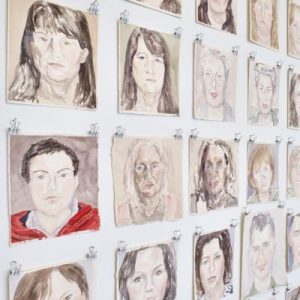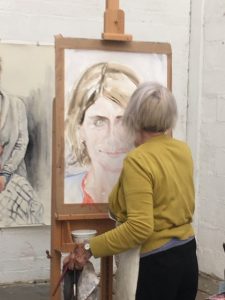As part of our investigation into personalisation, People Like You is working with artist Felicity Allen (http://felicityallen.co.uk). Up to fifteen people will participate in Allen’s Dialogic Portraits practice, sitting for Allen in her studio in Ramsgate, where she will paint their portrait and invite them to reflect upon the process – and personalisation – with her. Fiona Johnstone, postdoctoral research fellow with People Like You, sat for Allen and discussed her practice in relation to personalisation.
Fiona: Can you tell me a little more about the process of making Dialogic Portraits? The phrase suggests a conversation or dialogue; it reminds me of Linda Nochlin’s famous line about a portrait being ‘the meeting of two subjectivities’. I’m interested in how this relationship can be captured and made manifest in an artwork.
Flick. I’ve been working with Dialogic Portraits as a format for around ten years. Each sitting involves both talking and silence; each portrait is a document of the time that the sitter and I spend together. As well as creating a pictorial portrait, I also produce audio and video recordings, and make written observations. These then go towards making, say, an artist’s book or a film. I’m interested in how people respond to the experience of sitting, and in how they relate to the version of themselves that is given back to them in the finished portrait.
Fiona: The notion of series is important for dialogic portraiture, is that correct?
Flick: Yes, series, but also concept. Each series of Dialogic Portraits (Begin Again [2009-2014], You [2014-2016], and As if They Existed [2015-2016] and, currently, People Like You, Refugee Tales, and Interpreting Exchange) is informed by a concept that loosely links all the sitters in some way. For example, for Begin Again, which I started at the end of a decade of not-painting, I invited people who I had been working with [as Head of Interpretation & Education at Tate Britain] during that decade to sit for me. This enabled me to explore the limits of what we understand to constitute labour – intellectual, administrative, affective or domestic – and to think through the significance of this labour in relation to the production of both portraits and persons. For each portrait produced (76 in total), I wrote a diaristic note and recorded an interview with the sitter.
Fiona: I’m interested in the presentational format of Begin Again, which takes the shape of a two-volume book with images and texts (pictured), and also an exhibition (in 2015) where the portraits were hung as a wall-sized grid of faces (pictured). This configuration conjures several associations for me: a database, a filing system, or a rogues’ gallery. This reminds me of two textual reference points. The first is Siegfried Kracauer’s ‘The Mass Ornament’; Kracauer argues that in the modern period, people can only be understood as part of a mass, not as self-determining individuals. The second is Allan Sekula’s famous essay on photography, ‘The Body and the Archive’, where he explores the relationship in the early nineteenth-century between photographic portraiture, the standardisation of police and penal procedures, and the rise of the pseudo-sciences of physiology and phrenology (both comparative taxonomic systems which in turn contributed to the development of the discipline of statistics). Finally, it also made me think of an Instagram wall!
Flick: The associations with Instagram wouldn’t have occurred to me. I started working with the grid before I started using social media, and certainly before I was aware of Instagram [which was launched in 2010]. The grid was partly a practical solution to the problem of how to display multiple images within a limited space. For me, the associations of the grid would be minimalist or modernist – as in Rosalind Krauss’ reading of the grid – rather than to do with Instagram.
Fiona: That’s interesting. Krauss claims that the grid is a symptom of modern art’s hostility to narrative and to discourse – this seems antithetical to your own work, which connects image and text. She also describes the order of the grid as that of ‘pure relationship’, whereby objects no longer have any particular kind of value or order in themselves, but only in relation to each other. Perhaps this notion of ‘pure relationship’ might offer us a way into thinking about personalisation in relation to your work?
Flick: With the Begin Again wall I was certainly thinking about the individual in relation to the mass; the paradoxical effect of working with a group or series of people is that you starting thinking about them all as individuals. The format is also, crudely speaking, about taking status away from people by putting them alongside other people. It disrupts the way in which we privilege certain people. It’s vaguely political, challenging hierarchy.

Begin Again nos 1–21 (2014), Felicity Allen, 2-volume limited edition artists book
Fiona: It feels as though you are working with an enduringly humanistic notion of the person. In particular, you work primarily with the face, a part of the person that has longstanding associations with phenomenological presence. Your images are often closely cropped; the focus is solely on the face, rather than on any contextual details, such as background or clothes, that might give the viewer a clue as to the identity of the sitter.
Flick: I agree that the face has strong humanistic associations. I’m thinking of Levinas’ idea that the face is basically something that stops you killing people – it makes a demand on you, and that relationship is inherently ethical. In terms of contextual details, I’m now starting to crop my images much less closely, because I’m interested in notions of personal branding and role-playing through the way in which people choose to present themselves – through branded clothes, for example.
Fiona: I wanted to ask you about the significance of persona. Many of our conversations on this project have looked at personalisation in relation to digital technologies and data science. Digital personalization technologies reflect a longer preoccupation with the ‘person’ and the ‘persona’, and it seems to me that your work, which is almost resolutely analogue, might offer us a different way of approaching personalisation. The origins of the terms personalisation, personal, and personalise all stem from the Latin personalis or personale, which means ‘pertaining to a person’. Can we talk about the concept of persona in relation to your work?
Flick: The watercolours are resolutely analogue but there’s usually a kind of comprehensive digital work – a book or a film – which brings the series together. I am interested in how my sitters perform certain roles, but I’m also interested in the way in which I perform – or inhabit – the role of the artist. Begin Again was absolutely about getting people to see me differently, I had a strong consciousness of that very quickly. I was undressing as a manager, and dressing up as an artist.

Begin Again (2015), Felicity Allen, detail of exhibition installation during a residency at Turner Contemporary, Margate
Fiona: Do you find painting (someone’s portrait) to be performative?
Flick: It’s totally performative for both artist and sitter. We both find it exhausting, sitters as well as me.
Fiona: It’s a little like being on a therapist’s couch.
Flick: Yes, or at the hairdressers. But I try to manage the relationship to ensure that I’m not turning into the analyst or the hairdresser.
Fiona: How do you do that?
Flick: By talking back! And by being very conscious of how the sitting is going. But it does mean that I’m constantly retelling – or reperforming – my own stories.
Fiona: There’s a kind of labour, a selling-of-self, involved in that process of storytelling; that’s part of your exchange with the sitter. I’m wondering if you have read any of Isabelle Graw’s work on painting? Graw describes painting as ‘a form of production of signs that is experienced as highly personalised’. What she means by this is that painting has a direct indexical link to its maker; there is a close relationship between person and product. She links this to Alfred Gell’s definition of artworks as ‘indexes of agency’. As a ‘record of time spent together’, your work has a strong claim to the indexical.
Flick: Do you believe Graw’s argument?
Fiona: It’s seductive, but I don’t really buy it – why is this true of painting, but not of drawing or sculpture?
Flick: I don’t believe it, but I feel it. There’s something about the flow, the wet, that is very important about painting. I’ve got this board, and I’ve got paper on it. As I’m painting and I’m using my brush it’s like a proxy for stroking the face. There’s a brushstroke going on, and there’s a body that I could be stroking. It’s about touch, and feeling, and all that stuff – if I was to use a camera, I wouldn’t have that.
Fiona: So for you there is a strong sense that the (painted) portrait is a proxy for the person, but also that your tools are proxies for your own libidinal body.
Flick: Right.
Fiona: I’ve been trying to think about whether I have found my experience of sitting for you to be a personalised one. I think that I’d describe it as a personal or inter-personal experience, but not personalised, as such – for me, that term suggests an industrial process driven by big data and an infinite number of calculable relations based on things like likes and preferences. Understood in this way, personalisation seems to bear little relation to the highly individualised experience of a one-to-one portrait sitting. Perhaps we need a vocabulary that can differentiate between an experience that is individualised, and one that is personalised? Throughout our conversation, we’ve often both found it challenging to think about your work in relation to a dominant concept of [algorithmic] personalisation. In a recent essay published in Critical Inquiry, Kris Cohen notes that personalisation, and indeed networked life more generally, ‘disorientates all of our existing vocabularies of personhood and collectivity’. Do you think that this sematic disorientation might explain our difficulty in thinking through your work in relation to personalisation?
Flick: Absolutely!

Felicity Allen at work on a portrait of Fiona Johnstone, 5 September 2019, for People Like You
Works referenced
Linda Nochlin, “Some women realists”. Arts Magazine (May 1974), p.29.
Allan Sekula, “The Body and the Archive”. October 39 (Winter 1986), pp. 3-64.
Siegfried Kracauer, The Mass Ornament: Weimar Essays, trans. Thomas Y Levin. Harvard University Press, Cambridge, Massachusetts and London, England: 1995.
Ross Krauss, “Grids”. October 9 (Summer 1979), pp. 50-64.
Isabelle Graw, “The Value of Painting: Notes on Unspecificity, Indexicality, and Highly Valuable Quasi-Persons”, in Isabelle Graw, Daniel Birnbaum and Nikolaus Hirsh (eds.), Thinking Through Painting: Reflexivity and Agency Beyond the Canvas. Sternberg Press, Berlin; 2012.
Kris Cohen, “Literally, Ourselves”. Critical Inquiry 46 (Autumn 2019), pp. 167-192.